
Wednesday 5th February From storms to sunshine 39km (in Fuerteventura)
Britain had been battered by storms in the last few weeks. We woke to hear of a latest storm in the west country which had severely damaged the railway at Dawlish, with renewed floods. If ever there was a time to want to go for some winter sunshine, this was it!
We had escaped much of the bad weather in Hermitage, but it was still very wet and windy. Adrian had had to fix the leaking roof before we left. Off we went at 9.45, and then it was all was plain sailing!
We had no problems on our way to Gatwick, and our ‘meet and greet’ worked well. Our 1.40 flight to Fuerteventura took off just a little late - we were fortunate to have what appeared to be the only spare seat next to us.
We were soon through the thick, low cloud and on our way south. It was actually cloudy for most of the way. We could glimpse snowy peaks in northern Spain - probably the Picos d’Europa, then the sky cleared as we approached the Canaries. We passed over Lanzarote, and then came to Fuerteventura, with its tiny islet off to the north.
The airport was a pleasant surprise - very quiet and roomy. We appeared to be the only flight arriving, and unlike our recent return to Bristol from Geneva, our baggage was waiting at the carousel when we arrived there. Our only problem was finding the Europcar car hire, which was situated in an unmarked stone ‘hut’ in the car park. Adrian asked if everyone had trouble finding it, and the man said ‘yes’. It seems that as they didn’t want to pay to have a smart place in the actual airport, they couldn’t put up direction signs!
There was virtually nobody about as we set off, noticing immediately the vegetation - palm trees and flowering succulents. The sun was very low in the clear blue sky.
We started off on our way to our accommodation, but when we passed a supermarket, thought that we ought to buy a few things for tonight. This of course took a bit longer than anticipated, especially as I had to dash off to the loo, as always!
When we came out, it was dark! It was much further to Tuneije than Adrian had thought, so almost 8 o’clock when we reached the place. A young chap who spoke no English gave us the key, and after making a phone call, said that someone would be coming in 10 minutes (that we could understand).
The property was rustic and rural, with plenty of room. The nice thing was, it was warm outside as we looked up to the moon and stars.
We discovered that there was no oven, so we attempted to cook the pizza which we had bought for supper in a frying pan! Interesting!
The other young man arrived (he wanted our payment). He looked like the first chap - we thought that perhaps it was his brother. He gave Adrian a small bottle of local red wine.
When we looked around outside later, we saw another person coming to one of the other properties. Having unpacked enough for the night, we went to bed at 11 o’clock.
Thursday 6th February We settle in 76km
Our room was very dark, but I opened the heavy wooden door to peer out at first light, with the last star in the sky. Soon afterwards it got light, with a wonderful clear blue sky. We took in the surroundings, with a hill (Montaneta del Tamacite) up in front of us, and bougainvillea flowering in the yard. There was birdsong, and the ubiquitous cockerels crowing!
We sorted out our stuff before enjoying breakfast on the balcony, just as the sun reached it.
Adrian realised that we had no key to get out of the property - the chap had given him the wrong one last night and it has a locked gate. Luckily he just happened to be calling in at that point. (A bit later, Adrian had to scale the wall anyway, as he’d left the keys in the car!)
It was hot on the balcony as we sat there for morning coffee/tea.
We didn’t leave until gone midday, driving first through the village, and noting the cacti, palms, netted ‘greenhouses’, and a supermarket.
Everywhere was amazingly dry and barren as we drove south to las Playitas, and then on to the pretty lighthouse at Entallada, high above the sea. It was surrounded by completely barren hills, which had a strange attraction. Having taken in the view, we ate our sandwich lunch sitting on the wall by the lighthouse - we didn’t fancy sitting on the wall with a vertical drop to the sea! We were totally on our own for a while, then other cars and cyclists arrived.
We drove back to las Playitas, which we were pleasantly surprised to find was a really pretty blue and white village beside the sea. People were sitting at a restaurant by the beach.
We drove on to Gran Tarrajal (meaning large tamarisk, although we didn’t see any there) This again was very pleasant with a massive dark sandy beach, edged by lots of eating places and bars.
We decided to drive on round to the next place along the coast, Ginginamar. This wasn’t mentioned in the guide books as it was a ‘real’ village beside the sea. Local boats were pulled up onto the sandy beach which was mostly covered by large pebbles.
We now took a different route back cross country to Tuineje, where we stopped at the small and not over-inspiring supermarket, getting back to the villa at 4,30.
We were pleased to find that we still had sun on our balcony, as we sat there with our cup of tea, thinking how lucky we were, as it had apparently rained all day at home.
Later it became a bit chilly after the sun disappeared, and we sat with our aperitifs. Still much more pleasant weather than England.
Friday 7th February Wild coast and the oldest villlage 99km
There were a few clouds today, but we still enjoyed breakfast just as the sun reached us. Adrian went to the bakers and came back with some large smoky smelling rolls (cooked in a wood fired oven).
We left at 10 o'clock and drove north, soon passing an aloe vera nursery where a coach load of tourists were visiting.
We drove through Antigua, where a large craft fair is held at the end of May, then stopped at an unmarked pull off where I had my coffee. A few green plants brightened the otherwise orange landscape. It was a nice stop.
We drove on to the village of Llanos de la Concepcion where there were two pretty windmills which Adrian photographed.
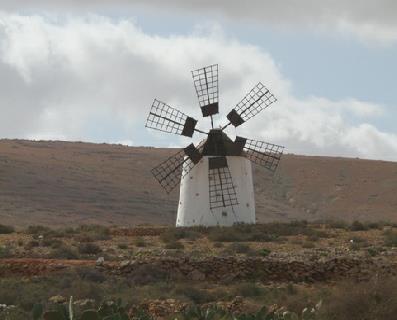

Two windmills at Llanos de la Concepcion
We now took a road towards the coast through Parque Natural de Betancuria. We passed a yard of goats in this arid environment, and wondered what they could possibly find to eat. The sat nav showed a large 'urbanisation' development , but there was virtually nothing! Someone's idea that didn't happen, like others we have seen. There was just a scattering of dwellings. We continued on an unsurfaced road to stop by the renowned wild west coast at Aquas Verdes, where waves were crashing on to the shore. One is warned not to swim from this coast, and there is very little access to it.
We drove back and then through Valle de Santa Ines on winding roads towards Betancuria.
We took the road to the Mirador de Morro Velosa. We were surprised to see several other vehicles parked by a modern building housing an exhibition with captions in Spanish, English and German explaining the history, geography and geology of Fuertaventura.
The view from Mirador de Morro Velosa
There were large viewing windows, a small cafe, and toilets. It just lacked picnic tables, so we ate our lunch sitting in the car.
There were more viewing points as we returned to the road to Betancuria – we tried to avoid the coaches stopping there!
We made our way to Betancuria – the oldest town on the island, and the former capital. We had a nice walk around amongst the white painted houses. We looked at the church, but didn't go inside. There were some tourist shops, and quite a few visitors, but it was all very pleasant. Adrian liked the old well.
We continued south to Vega de Rio Palmas. From here you could walk along a dry river valley to a small chapel known as Virgen de la Pena. We contemplated whether to, but thought that we would attempt it from the other end, where we were driving anyway.
We stopped at a viewpoint from where we could see the little white chapel, and a completely dry reservoir. There were coaches here too, but we enjoyed seeing little birds which we looked up to be Spanish sparrows. I had just commented that one might expect to see a ground squirrel in this environment, when sure enough there was! It was a Barbary ground squirrel.
At Mirador de Feruca, a bit further on, we saw another different bird – a Berthelot's pipit.
We now drove through the village of Pajara towards Ajur. We came to a small road which we followed, and then parked so that we could walk towards the chapel we had seen in the Pena gorge. It was really hot as we walked along the rough track, having gone wrong at first and wandered through farmland, then had to scramble up. The way then went through an area which had wire fencing protecting 'pheonix canariensis' (Canary Palm). The path became quite rough. We could see the chapel, Virgen de la Pena, but decided against attempting the last rocky bit, and returned to the car.
It was now 4.15, as we made our way to Ajur, another of the few accesses to the western coast.
Once more we were surprised by the number of people about at this out of the way place. The beach was of fine black sand, and beyond it, the waves were crashing violently – not a place to swim!
We followed a rough path along by the sea to look at the superb coastal rock formations. We could have stayed longer, and kept it in mind for another day.
It was now 5 o'clock, so we made our way back to Pajara, where we stopped to look at the 'must see' church (closed, as we knew). We bought some frozen seafood and rice from a small Spar shop, and got back to our place at 5.45. Somebody called Magdalena greeted us as we arrived. She indicated that she was the mother of the 'lads' who had booked us in.
The sky was now clear blue, but it felt quite cool as we sat with our drink on the patio.
Saturday 8th February Lovely unspoilt villages by the sea 109km
We didn't leave until quite late today.
We set off south, enjoying the white villages against the blue sky and thinking how lucky we were, as England was still suffering rain and wind.
We turned north before Gran Tarajal, to drive up the eastern side of the island.
The first road we tried to 'explore', at Teguital, soon became unsurfaced, and then very rough, so after some distance we returned. We saw two cyclists and two cars, obviously continuing to the coast.
The arid scenery looked very beautiful against the blue sky – we thought that we must be getting used to the dryness of Fuerteventura.
We now drove through the lava fields of the 'Malpais Grande'. At the turn off to Pozo Negra there were signs to an 'experimental finca', with a massive car park. We couldn't see much sign of anything happening, so wondered if it was another of those grand ideas that didn't happen.
Along this road, we took a bumpy track across the lava to Poblado de la Atlayita. These were the ruins of the earliest settlement on the island. There was a low rope across the entrance, and a sign saying 'temporarily closed'! Adrian looked through the windows of the half underground visitors centre but couldn't see much. There were covered picnic tables in the barren grounds. Arrows pointed to the former village, so we were able to wander around amongst the lava 'igloos' of the aboriginals. It was wonderfully warm, and made us think of being in parts of USA. We saw a bird which we think was a Fuerteventura chat.

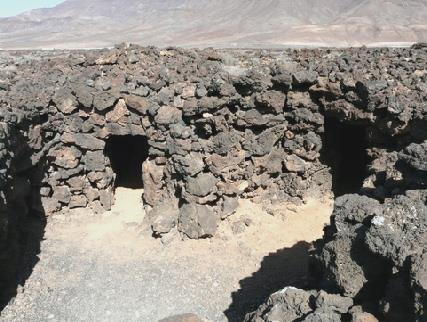
Poblado de la Atlayita
We bumped back along the track, and continued to Pozo Negra (meaning black fountain.)
This gem of a fishing village consisted of a few white houses beside the black pebble beach. We found the little low-key restaurant and sat facing the sea to enjoy fish soup(R) and tuna(A), each with a beer. Just one lady seemed to be serving and cooking for the several customers. We were watched by two black cats. It was a wonderful surprise to find such an unspoilt place on an island which has become such a tourist haven.
We drove back to the road, turning off next to la Salinas – the salt pans. Again there was a small village of white houses beside the sandy/pebbly beach. We could see the area of salt pans, and walked around by them, but didn't visit the museum. There was a huge skeleton of a whale displayed.
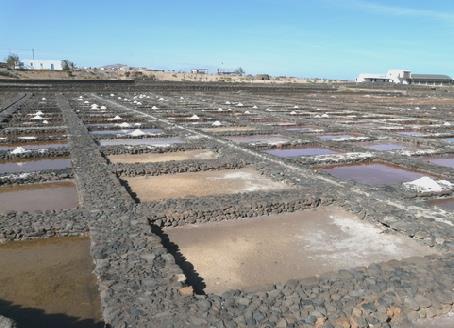

An unsurfaced track led south from here to Puerto de la Torre. This was another lovely little cove with a sandy,pebbly beach, and the remains of an old lime kiln. A couple of motorhomes were parked up here, what a nice spot!
We really enjoyed wandering around before driving a short way up the Barranco de la Torre. This dry river bed had palms and tamarisks and a few low growing bold little plants. We soaked up the atmosphere, reminding us of similar places in Australia.
Now it was time to return. The track did follow the coast to Pozo Negra, where we had been earlier – oh for a four wheel drive!
Just north of here is the ever expanding development of Caleta de Fuste – what a contrast! We didn't stop! We had driven through here on our way from the airport, and as then, we stopped at the Mercadona supermarket (this time I knew where the loo was!) We needed to buy a few things as tomorrow is Sunday. We made our way back to Tuineje via Antigua, enjoying the many evocative windmills and the lovely scenery.
We got back at 5.45, and sat with a cup of tea and some warm bread on the patio in the last of the sun.
Sunday 9th February Our first cloudy day 163km
Our first cloudy day! Hence we ate our scrambled egg breakfast inside, but this did have the bonus of being able to hear Hardeep Singh Kohli presenting Good Morning Sunday on Radio 2, with guest Eddi Reader. The scrambled egg was a bit of a challenge, with no implements, and no non-stick pan, so it stuck! We had heard the BBC News, with more floods in Somerset, and a problem at Burghfield Grid, Reading.
We left at 9.15 and headed north. At Antigua we were pleasantly surprised to pass two vintage cars.
We followed a route to the west coast, to El Puertito de los Molinos. We had stopped to photograph some little birds on the way. There was nothing here except a few simple white and green houses, in need of a repaint! A stream flowed down, with a few ducks – an unusual sight for here. We walked up the steps on one side and watched the crashing waves. We walked back and past the little houses and one simple restaurant advertising 'Canarian Seafood'.
We then walked inland a short way, past succulents growing by the running water.
By the time we left, quite a lot of cars had arrived at this simple little place.
We now had to drive back, though Las Parcelas, where a track led to the largest reservoir on the island, which is usually dry!
We came to Tefia where there is an outdoor eco museum telling of life in early times, but being Sunday, it was closed! We drove on past Tindaya, with Mt. Tindaya up behind. This barren mountain has had spiritual significance for local people.
We now followed a very long road to the sea, most of it really rough. At the end were two concrete dwellings – one inhabited by 'alternative people', and the other used as their hen house, it seemed! It was very blowy, so we ate our lunch in the car before wandering out to the edge of the sea. Like the Nullabor in Australia, we ended at cliffs high above the water! This area of desert was one of the 'failed developments' of the island. It seemed to be called la Huesilla.
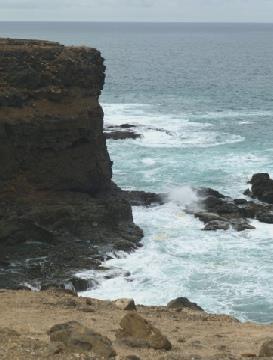

The cliffs and two lone dwellings at la Huesilla
We drove back, passing a group of wild goats.
We then drove through Tindaya and north to El Cotilla. This is one of the few villages on the west coast, and is said to be rarely busy, but being Sunday afternoon, the bars and restaurants were full. We looked down to a small harbour, and walked along to the simple castle, built to keep out the marauding pirates. There was just one tower, which you had to pay to walk up. We viewed from below, and walked back past the former lime kilns.
We then followed the road north to the lighthouse Faro de Toston. This was past another 'failed development', with wide roads and some street lamps. It confused us, as the road we wanted was blocked off, and we had to follow the 'estate' road.
Finally we arrived at the lighthouse, set in delightful surroundings, looking across to Lanzarote. A sign told of fossils on the beach, but we couldn't see any. The beach was of sand and lava, and was gloriously remote. The museum was closed, being Sunday, so we just had to enjoy the surroundings.
On our return to El Cotillo, we stopped at a wonderful white sandy beach. An off shore reef protected the beach, so the sea was calm. Several people were out swimming. I had a short paddle, and found the water not cold. It was a gathering place for motorhomes – and what a place! Delightful!
Now it was time to make our way back. We drove past two windmills at Lajares, and despite going a bit wrong when concentrating on making the ipod work, arrived back at Tuineje at 5.30.
There was no sitting on the patio in the sun this evening! We were able to skype Emma, and to talk to all three 'boys' (and their children) on the phone before cooking our sea bass for supper. Afterwards we enjoyed listening to a programme on Radio 2 about lovely broadcaster David Jacobs, who died last year.
Monday 10th February A lovely cove all to ourselves 68km
We were disappointed to wake to a partly cloudy morning, but as Adrian saw from the weather map, it became hot and sunny by lunchtime. We still ate our breakfast on the patio.
We left at 11 o'clock, driving first to Pajara. The church was open this morning, but it is obviously on the coach route, and tourists spilled out for their quick look. Outside the church, a donkey was 'posing' beside a mill wheel, As we had driven past, it was walking around turning it, but when we walked back, it was just standing still for the tourists.


The church at Pajara and the donkey outside
The church was very dark, with an elaborately ornate altarpiece.
We drove south, ascending a winding, arid pass (Sisacumbra). We stopped at the viewpoint – it was very windy as we viewed the dry slopes.
We continued south towards la Pared, turning off beforehand onto a long, winding, unsurfaced track, eventually coming to a remote beach of dark sand, scattered with light and dark pebbles. It seemed to be called Playa de Ugan. We were completely alone as we sat on a raised bit of beach to eat our lunch. After a delicious laze in the sun we walked along the beach. It was very windy, and the waves were enormous.
We returned to our car, parked among the tamarisks, and drove on to La Pared. There was a small amount of development here, but not unpleasant. We parked above the cliffs of this splendid coastline – it was very windy!
We could see wide steps going down to the beach, but the sea was swishing in, making it impossible to get on to the beach. Except for the kite surfers that is! We joined one or two others to descend the steps, from where we could see first one, and then another kite surfer having a wonderful time. Not for me though!

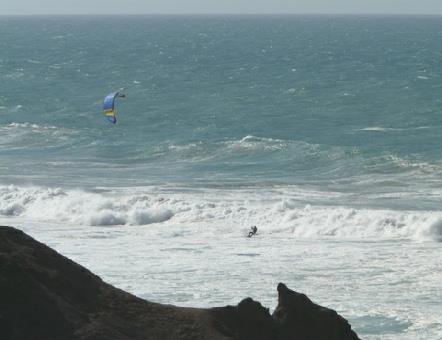
Wild La Pared with an intrepid kite surfer
We now drove back to Tuineje, via the Hermoses valley at first. We stopped to get some petrol, before going into the supermarket opposite to get some batteries for the computer mouse. The shop didn't have any, but the garage did!
We were early enough to sit in the sun on the patio.
We had been pleasantly surprised to find that we had clean towels, and clean sheets on the bed – we hadn't expected this. We had passed Magdalena as we left this morning – so presumably she had been coming to clean.
Tuesday 11th February To the far north of the island 157km
There was a clear blue sky today but with a strong cool wind, so we gave up on sitting on the patio for breakfast!
We left early and drove north to La Oliva. We had planned to visit Casa de los Coroneles, the 'Colonels house', apparently the most important historic house to visit. We pulled up first in a vast carpark beside a long white wall – but this turned out to be the cemetery! The house we wanted didn't really have a car park, and unlike the free entry mentioned in our book, it cost 3 euros to go in! It had a crenellated top, but didn't look too special. Adrian preferred the decrepit outbuildings! We think that the house was being renovated – a lorry outside was delivering furniture, spoiling Adrian's photo – and so now there is a charge to go in. We didn't!
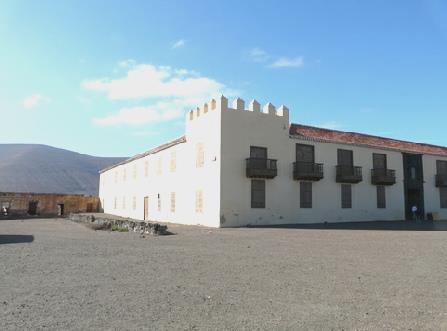

Casa de los Coroneles and the outbuildings
We made our way to the large town square and walked amongst the palm trees to the attractive church which was quite simple inside with white painted walls.
We missed seeing the grain museum as we found our way north, through Lajares again with its two windmills. We stopped at a supermarket where we bought all we needed including a loaf. This was from a separate bit at the front, where the lady who served us then came across to the main till!
We followed the sat-nav on a convoluted bumpy route to a road with the only access to the northern coast. This ended at Playa de Majanicho, a delightful little cove edged with a few white houses with blue or green doors. Beyond it was a surfing beach, which was busy.
We walked along by the cove, greeted by a goat! A young chap enthusiastically waded into the water over the pebbles, but never managed to find it deep enough to swim! From here, an unsurfaced road leads for 8 km around by the seashore to Corralejo. The inland route was 20 km. After deliberation, we took the pretty route, and it was lovely! At Playa de Tinosa we stopped to walk onto a little cove of black rocks and yellow sand.
Corralejo has a port, but is really a tourist town. It wasn't particularly attractive, but wasn't bad either. From here you could get a ferry for the short way to the hilly little island of Lobos, and also to nearby Lanzarote.
We walked down to the sandy main beach, which was very pleasant and low-key. However, it was not our sort of place, being full of tourist shops and eating places – 'Murphy's Bar' and 'Best restaurant in town'. It was lunchtime, and we really would like to have eaten at one of them, but nothing appealed to us at all. All too touristy!
We opted to drive out of town to the famed sand dunes of El Jable. The road we wanted was closed, and life was getting rather difficult! In the end we drove down the closed road, and found our way towards the vast area of dunes. Everybody else comes here too, so finding a place to stop wasn't easy, and Adrian was getting hungry!
We would ideally have liked a picnic table, as we were making up our own sandwiches, but we haven't seen anything like that on Fuerteventura! In the end, we parked and walked into the dunes, overlooking the fantastic azure sea.
It was very windy, so cutting and buttering bread and opening a tin of sardines is funny in retrospect! Having eaten, we just enjoyed the lovely situation.
We drove south, and soon came out of the area of sand dunes and the soil changed to a reddish colour. We turned off on to an unmade road to la Puntilla, a little harbour with small boats and a scattering of white houses with blue doors. Once again, there were abandoned urbanisations nearby.
On south again, when just before Puerto del Rosario, we turned inland on a road which went for a few miles before becoming just a track. It ended at Guisguey, a scattering of houses and a little church, with the low earth walls making terraces, which we see so often. Back on the coast road, we turned down to Puerto Lajas. White houses surrounded a dark beach which had play things and a large notice of regulations. A couple were getting ready to kite surf – it was certainly windy enough!
Puerto del Rosario is the capital of the island, and a very low-key one! It isn't at all touristy. At first we had come down to the sea at just a rough bit of ground. We drove through, but couldn't see anything to stop for!
Now it was time to make our way back. We drove via the village of Triquivijate and got back to Tuineje at 5 o'clock.
Wednesday 12th February Conurbations and lovely beaches 184 km
It was disappointingly cloudy again, so no patio breakfast. Much better than the weather in England though, which is still dire with rain and wind, and severe weather warnings for the whole country!
We left at 9.30, stopping at the bakers, with its beehive shaped, wood fuelled oven outside. We drove south to Tarajalego, a pleasant place with a dark sandy beach and cliffs of black and orange lava surrounding it. The sun magically came out as we walked along the smart 'prom' past the nice little houses to the 'pier' and back on the sand. There were a few beach 'umbrellas' like one we have a photo of us by in Majorca in 1973. We had to do a copy. We sat on a seat and ate the cookies bought at the bakers, but they were much too sugary.
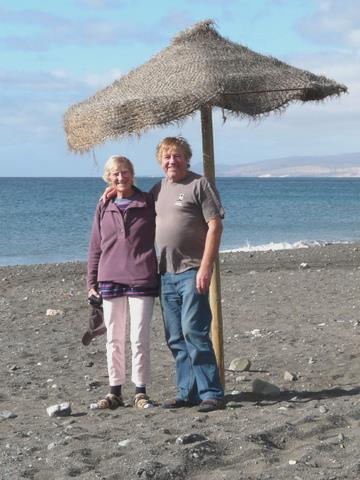
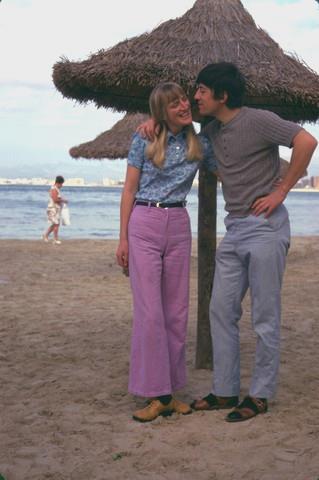
Under a beach umbrella - and memories of 40 years ago!
We continued southwest, past the roadworks for the new motorway being built. We drove past La Latija, where the roundabout was a mass of bright geraniums – a rare sight here. Palm trees abounded in this area, as we approached the real tourist part of the island. It was in sharp contrast to the usual desert, and we wondered how much water was being used to water them.
We reached Costa Calma, and hit the holiday development – never ending rows of balconies, not attractive to us. We walked down to the beach, where the restaurant and swimming pool for the development were situated. Rows of deck chairs were lined up on the beach – we didn't stay long!
We continued to Playa Barca, where a sandspit makes a lagoon. There were a couple of high rise blocks beside the huge sandy beach and azure sea. This was the kite surfing and windsurfing area, and was very busy. We took the 'lagoon 'road, which was in fact a bumpy track more suited to 4x4s, so we returned and drove to the other end of the sand spit at Risco del Paso, which was much more us! There were windsurfers here, but it was really peaceful. We lazed on the wide sandy beach, looking out to the deep blue sea. For the second day running, we made up our sandwich lunch amongst the dunes.
At 1 o'clock we left to drive past the many conurbations which make up Morro Jable. From here, a road continues for 20 km or so to Punta de Jandia, the extreme SW of the island. We hadn't expected to be able to drive this, but it started off with a tarmacked surface, and then became a track with a reasonable surface, so we continued.
The surface deteriorated, but we didn't want to give up! The scenery was a very arid monochrome brown, but had a strange fascination. We came across 3 wild donkeys and some wild goats. The last mile was actually surfaced, but was bumpier than the rest! Just before the lighthouse Faro de Jandia there was the tiny white village of Puerto de la Cruz. At the lighthouse, we could see both the calm southern coast and the wild NW coast. Wonderful views! Inside the lighthouse was a display with descriptions, (not always well translated) in Spanish and English, of the geology and natural history. Several other people had made this adventurous journey – one or two had actually cycled.
We now had to drive back the 20 km to Morro Jable. A little way past here, at Mal Nombre, we found with difficulty a road going inland following the Barranco de los Canarias. We'd had to drive through the petrol station to get to it, and there were certainly no signs! We couldn't decide whether the road had a surface or not, but we drove on to a 'viewpoint' Degolleda de los Canarios (350m) – the end of the track, right above steep cliffs down to the fabulous northern coast with its sandy beach and blue sea.
We could see right along to Punte Pesebre, the top of the 'toe' of the Jandia peninsula. The island is narrow at this point, so we could see down the valley to the coast at the south too. We saw more wild goats as we drove back.
We continued our homeward journey, stopping at la Lajita, which we were delighted to find was a 'real' Canarian village with little boats, a square with a white and lava church, and one little bar by the beach.
Now we made our way back to Tuineje in the late afternoon sun, arriving at 5.30. It had been another good day.
Thursday 13th February Finding out more about Fuerteventura 110 km
Once more there was a cloudy start, but the day became very sunny later. We had heard of renewed gales in England, with 80,000 homes without power.
By 10 o'clock we were on our way, taking a track from Tiscamanita towards the former volcanic crater of la Laguna, whose lava forms the malpais grande we had driven past the other day. The road we followed became an unsurfaced track, and then we came to a quarry and 'no entry' signs! We returned!

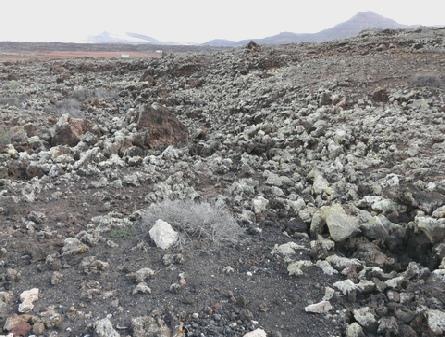
At Antigua we stopped at the bread 'boutique' and bought some rolls and a pain au raisin type bun. We drove on to the village square by the church, and ate our bun before looking at the church, which was white both inside and out. We had been surprised by the loud booming of bells for 11 o'clock, which had come not from the church tower, but from somewhere unseen close by!
We drove on to Tefia, where the outdoor museum would be open today. It was 5 euros each to walk around the scattered collection of traditional houses. It was pleasantly set out, and we had a little map to follow. There was even a camel posing. In one house, a donkey was tethered to the mill wheel, but again we were out of luck -he had performed for a group of school children, but stopped as we got there! Apart from this group, there was just one other couple visiting. We saw several homes with with a variety of artefacts - pottery, weaving, tin work, and a lady sewing intricate embroidery. The living rooms were reminiscent of the place we are staying at.
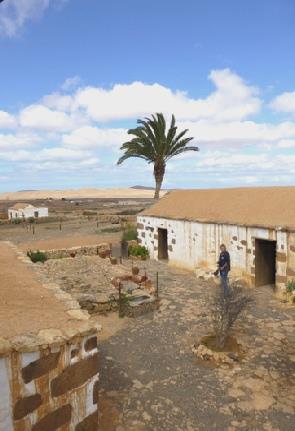
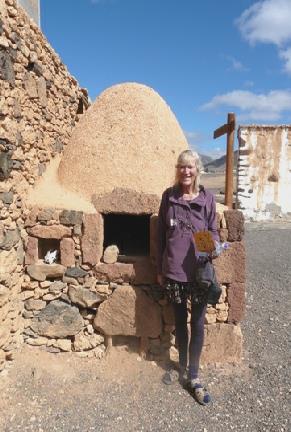
It was lunchtime when we'd finished, so we headed for Tindaya, where we hoped that we might find somewhere to buy a bit more for lunch. We eventually did see a tiny supermarket, but right next door was a little cafe. We decided to have some lunch there and the owner turned out to be English! He came from the Midlands and had lived in the village for 14 years, and run the cafe for two. He was happy to have left the high powered restaurant manager job that he had in England and more locally in Corralejo, and had made a happy association here. It was good to chat about Fuerteventura with someone we could understand. It was a simple cafe - we ate goats cheese, olives, anchovies, bread and crisps (and Adrian had a toasted sandwich) and drank a beer. By now the weather was hot.
We drove on to La Oliva to find the grain museum 'La Cilla', which we had missed the other day. This was housed in a grain barn, and consisted of large photos and artefacts to do with grain growing, which had been a mainstay of the island. The captions were in Spanish, but we were given a booklet with an English translation. It was interesting to see the variety of grain grown in the past - wheat, barley, corn, lentils. Donkeys, cattle and camels were used to pull the ploughs. We hadn't realised how much camels had been used on the island. 1.50 euros each seemed a good way to find out about this bit of agricultural history.
We drove on now to Vallebron, and to a valley which apparently receives a little more rain than elsewhere, and is therefore more fertile. There were palm trees lining the road, but we couldn't see evidence of much else. It did give us a nice view of Tindaya village and mountain.
From here we drove to Tamariche, hoping to ascend the hill of Temejereque, which would give views of this part of the island. Once more we were thwarted! The road became a rough track through the red earth! As Adrian had finally looked at the conditions for the car hire, which stated 'no driving on unpaved roads', we thought it a good idea not to proceed (after already having done a total of some 70 km)!
We made our way back to Tuineje, driving right through the little villages of Tetir and Aguas de Bueyes, and then stopping at the shop to buy something for supper. We ended up with frozen paella ingredients - nothing was very inspiring. We also bought a large fresh corn on the cob, but laughed when we took off all the greenery - it was the size of a small carrot!
Adrian went back to the garage to wash the evidence of our 'off- roading' from the car – it cost him 1 euro!
!The paella was actually good, when we'd worked out the cooking instructions!
Friday 14th February Valentines Day, and a wonderful last day. 36 km
We'd decided that this was going to be our 'lazy day', and it couldn't have been any better! The weather was perfect, with sunshine all day (21°C).
It was warm as we sat on the balcony for our 'Valentines day breakfast'.
We left late morning and drove back to Ajuy, on the west coast, enjoying the red scenery dotted with green against the blue sky. We had come here last Friday, but had only walked a short way on the rough path beside the sea, so today we wanted to walk to the caves.
Being lunch time, we decided to eat first. We sat at a restaurant by the beach and enjoyed a nice tapas meal which came with a bottle of wine and included sardines, mussels, mild chillies and cheese. We spoke to a Danish woman on the next table who came from Silkeborg in Denmark, where we had visited Val Gam last year!
Having thoroughly enjoyed our meal, we set off to walk along to the cave. The scenery is fantastic, with the wonderful blue sea down below.
We had avoided the groups from the coaches which had stopped here, and I was really pleased to get right down into the cave.
We stopped at the lime 'ovens' on the way back, and then had a deserved laze on the black sand beach. It was so quiet - the only sound was the crashing of the dramatic waves. One man was out surfing. We both had a paddle, and got quite wet from the erratic waves! Luckily there was a foot wash on the beach to wash our sandy feet.
We set off back at 4 o'clock, but I spied a cafe next to ours selling 'proper' ice-cream, so we stopped for our first ice-cream of this trip.
Then it was back to Tuineje, where we enjoyed the pleasant sun on the balcony for the last time - tomorrow it is forecast to rain! And in England the weather is still abysmal.
We opened some Valentine's Day bubbly, which we finished on the balcony.
Saturday 15th February We CAN make it rain anywhere! 74 km (in Fuerteventura)
Yes it did rain! Better weather than England though, where storms had caused more destruction.
We got packed up, then walked up to the supermarket for two rolls for 'tea', and back via the (closed) church and the camel statue. We had picked a more or less dry spell between the showers, which were sometimes heavy, and continued all day.
We had 'coffee' sitting on the balcony under the shelter, and left late morning. We hadn't seen anybody, so we posted the keys through the letterbox.
We drove down to Gran Tarajal and walked along the seafront as we had done on the first day. We looked at all the eating places before coming back to the first one. We sat outside under the canopy, but it wasn't a good choice. They had no fresh fish (too wet to go out, he said), so we chose 'fish cordon bleu' (or 'Gordon blu')! ( We had forgotten that this meant filled with ham & cheese) It was 'prepacked', and wasn't the best, Very disappointing for our last meal.
The showers continued as we drove back to Pozo Negro where we had a short walk on the stony beach in the other direction from last Saturday. We stopped by a little house which had a garden crammed full of colourful plants.
We drove on to El Castillo (which goes under different names) and made our way down to the harbour. This is a vast area of low level development, which didn't appeal to Adrian at all! It was busy with tourists who seemed to have just arrived, and were walking out in the unusually showery afternoon.
We then had a search for a petrol station so as to leave the tank full. Having done that we wanted to stop for a last snack, but being close to the airport and Puerto Rosario, the capital, this wasn't easy!
We pulled in above the coast just past the airport in the end, and enjoyed seeing a double rainbow.
Then it was back to the airport, where we had the difficulty of finding the right car park to return the car to Europcar. With no signs for the place, we had entered the wrong car park first, but luckily managed to get out without having to pay.
All was well in the end. We went into the airport building. What a contrast from the empty terminal building we had arrived at 10 days ago! It was jammed packed, and there were queues just as long as ever. We were asked if we wanted to put a cabin bag in the hold, as the plane was full. We decided to put Adrian's bag in, but afterwards he worried about his computer being in there, but all was well. It did mean that I could carry on our bag with our food in it without being questioned.
We had seen that our flight had come up with 'delayed' beside it, which hadn't surprised us, after the bad weather in England. In fact we were eventually 1½ hours late in taking off, having been sent to 'boarding' before our plane had even landed!
Once on the plane, we had missed our 'slot', so had to sit on the runway. The accommodating chief steward had handed out glasses of water, but just as he was doing that, we started to taxi.
We had remembered to buy two bottles of water for the flight (having had to throw out our spring water of course), which we still needed. (even if I did leave what was left of mine behind when we got off). Luckily I didn't need any on the homeward journey.
There was the glorious sight of the full moon rising as we took off. Despite what we had been told, the plane wasn't completely full, and we ended up with a spare seat beside us after someone had moved.
All went well - we landed at 11 o'clock and collected our bags (we realised that we had no distinguishing mark on Adrian's hand luggage, which we rectified when we got home!) Our 'meet and greet' worked well. We left Gatwick at 11.45 then (unlike previous times) had a clear run home to Hermitage, arriving at 1.00 am. We had escaped the violent English weather, and the next day was beautiful.
We had really enjoyed Fuerteventura.
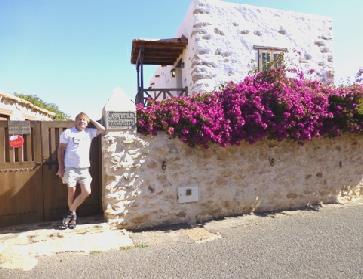
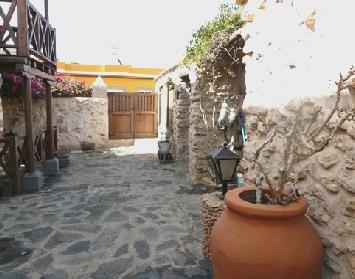
Views of where we stayed

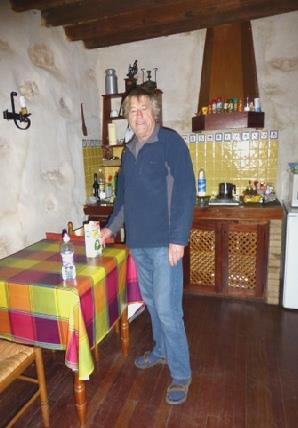
Overall distance travelled was 1115km

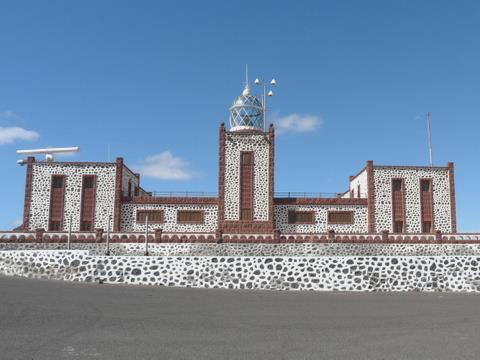




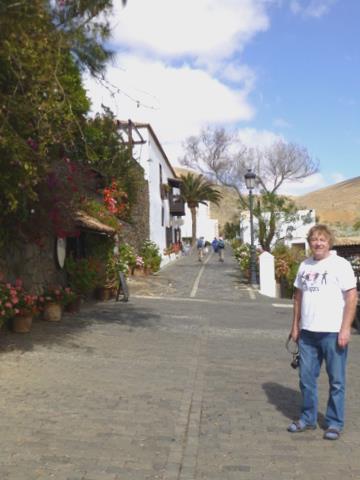
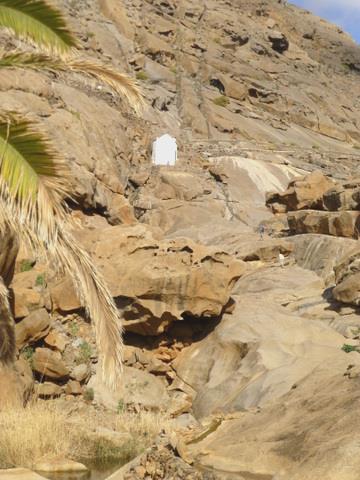
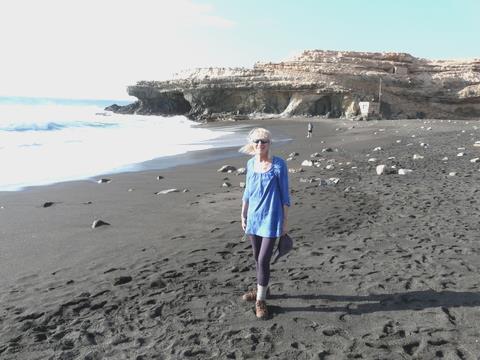
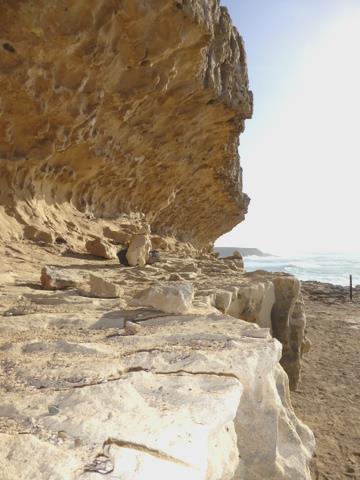
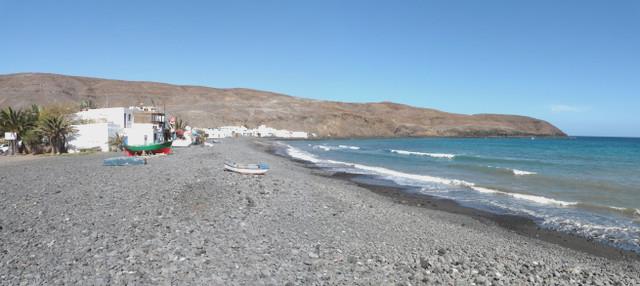


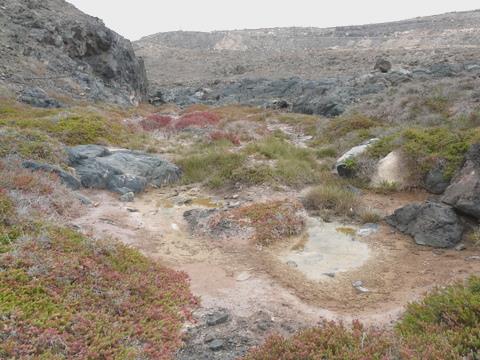

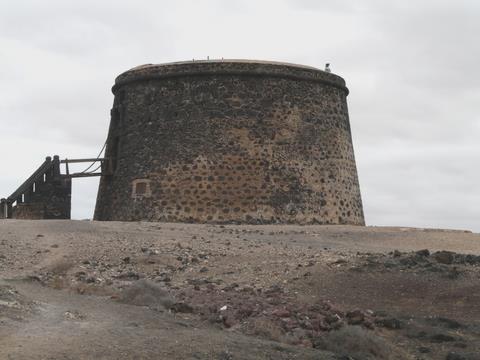
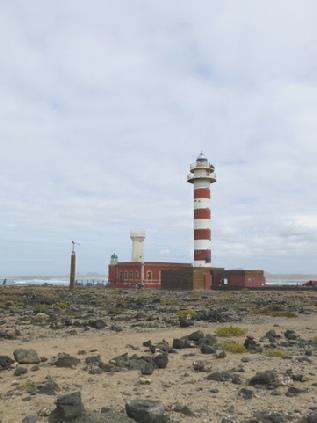
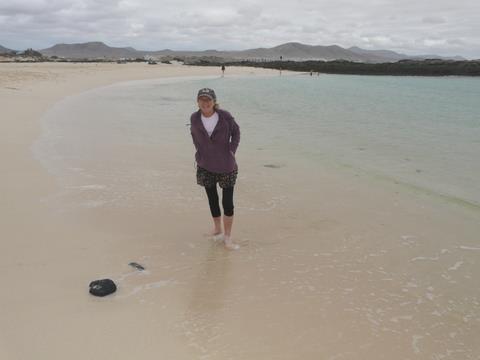
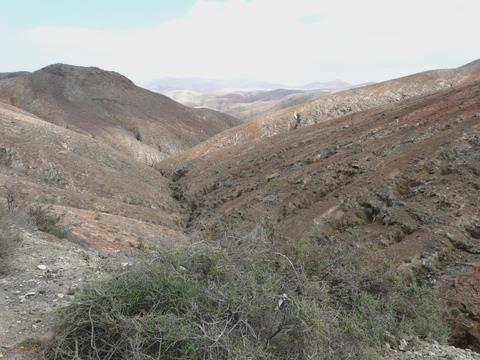
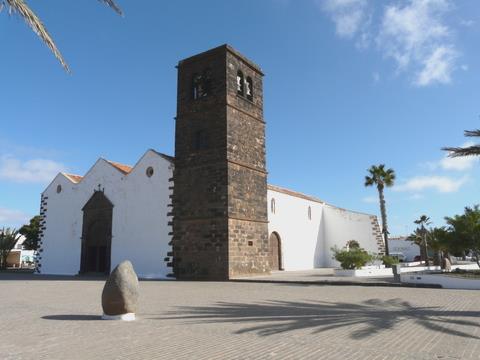
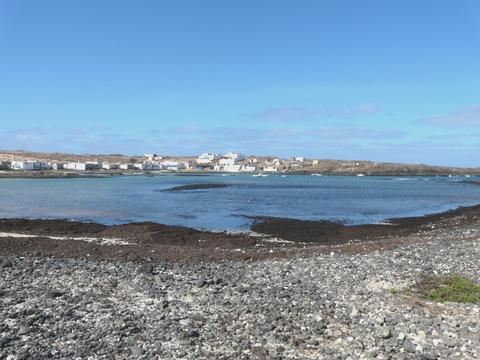

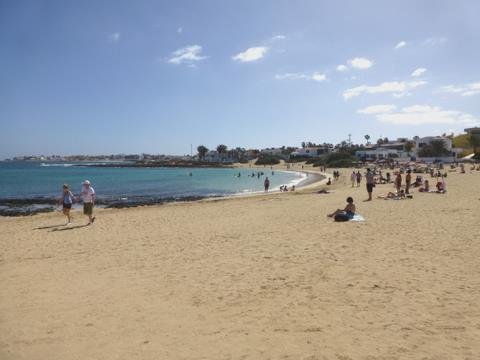
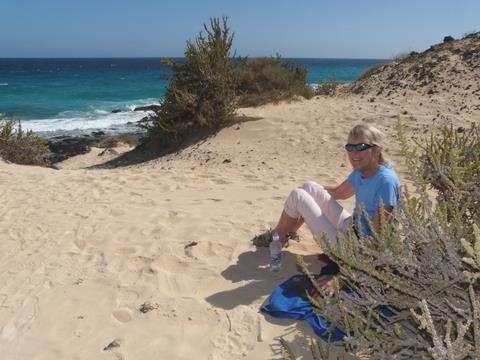
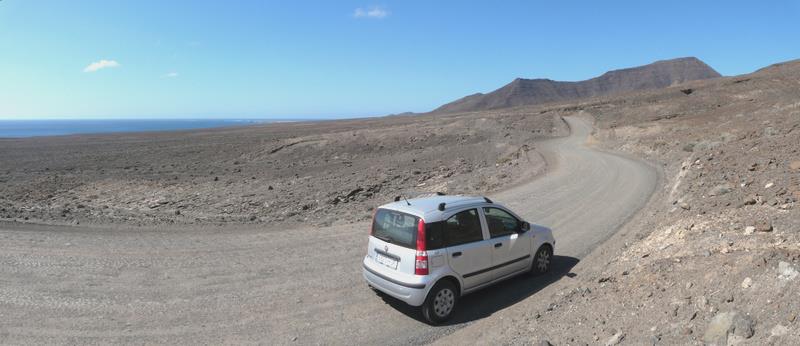
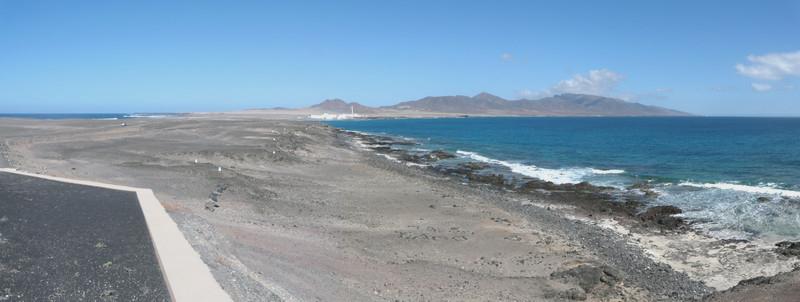
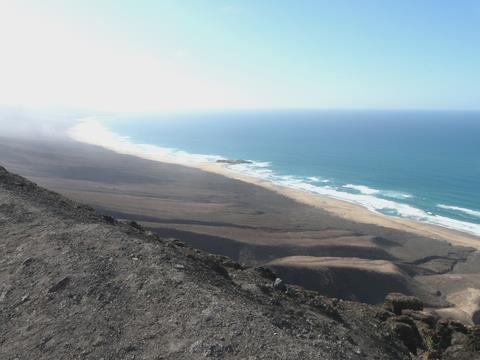

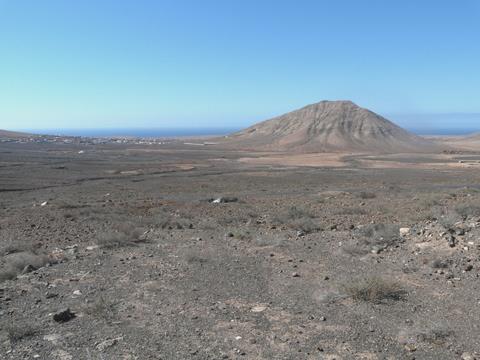
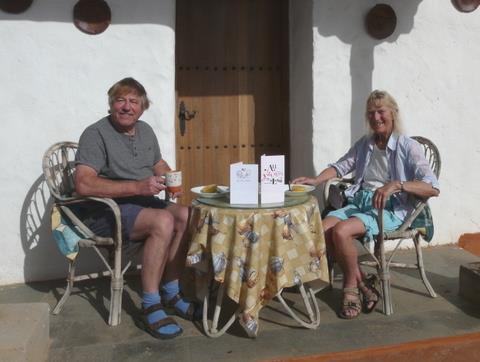
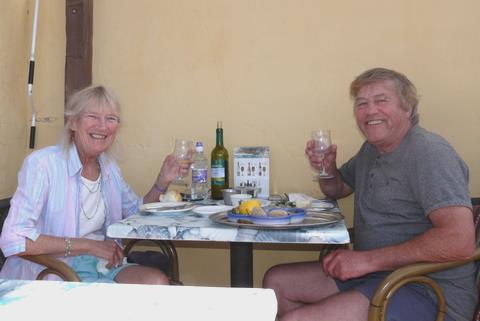
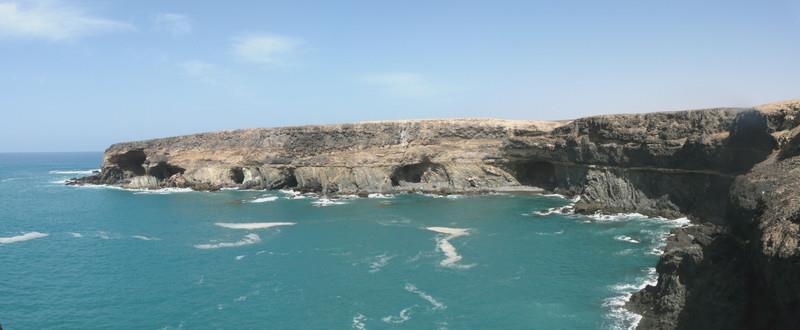
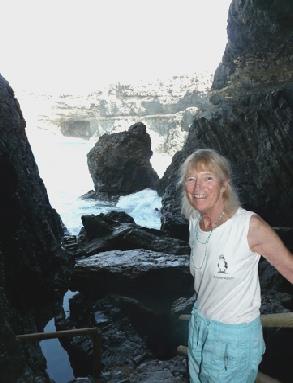
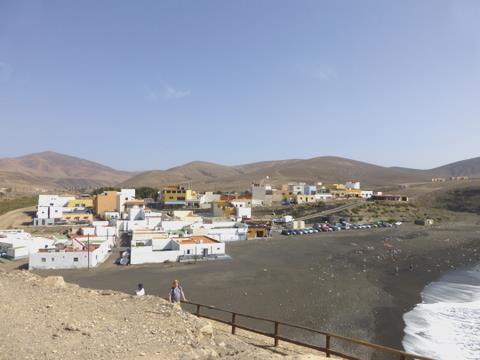
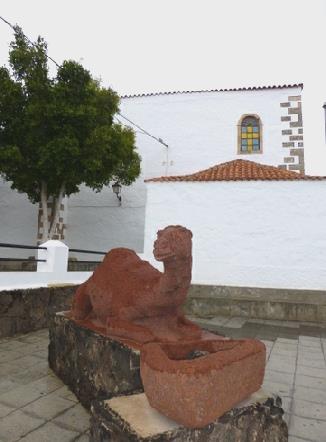
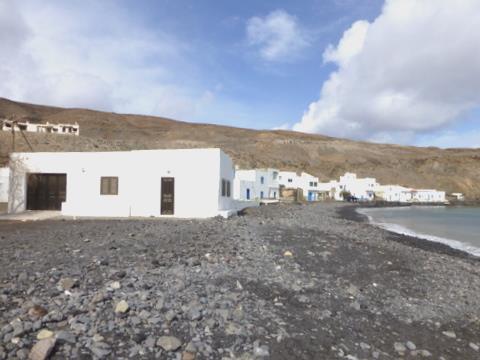

Elevenses on our balcony
Entallada Lighthouse
Las Playitas
Ginginamar
Betancuria
Ermita de Virgen de la Pena
The beach at Ajur
Wave Rock?
Pozo Negra
Salt Pans
Rosie at las Salinas
Puerto de la Torre
El Puertito de los Molinos
The first ‘fresh’ water we had seen on Fuerteventura
The ‘castle’ at El Cotolla
Faro de Toston
Another paddle
Arid Fuerteventura at Sisacumbra
The wonderfully isolated beach at Playa de Urgan
The Church at La Oliva
Playa de Valle, Aquas Verdes
Playa de Majanicho
Playa de Tinosa
The beach at Corralejo
El Jable
The road to Punta de Jandia
The view from Faro de Jandia
Degolleda de los Canarios
La Lajita
A dry field!
Malpais Grande lava
Outdoor museum, Tefia
Rosie by a traditional bread oven
Tindaya
Valentines day breakfast
Lunch at Ajuy
Coastal caves at Ajuy
At the entrance to the cave, Ajuy
Ajuy
The camel beside the church, Tuineje
Pretty Pozo Negro
Fuerteventura 2014





